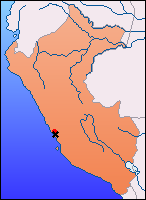 |
Related pages: |
 Located about 40 kilometers south of Lima, Pachacamac is one of the most important archaeological sites on the Peruvian coast. This vast ceremonial complex, dedicated to the creator god Pachacamac, was a major pilgrimage site for centuries, attracting visitors from across the Andean region. Its majestic temples and ceremonial plazas bear witness to the religious and political significance of Pachacamac in pre-Columbian Peru.
Located about 40 kilometers south of Lima, Pachacamac is one of the most important archaeological sites on the Peruvian coast. This vast ceremonial complex, dedicated to the creator god Pachacamac, was a major pilgrimage site for centuries, attracting visitors from across the Andean region. Its majestic temples and ceremonial plazas bear witness to the religious and political significance of Pachacamac in pre-Columbian Peru.
Pachacamac was one of the main religious centers of ancient Peru. The god Pachacamac, believed to be the creator of the world and responsible for earthquakes, was worshipped by several civilizations, including the Lima, Wari, Ichma, and later the Incas. Pilgrims came from afar to pay homage to the god and consult the oracle, renowned for predicting the future.
The complex includes several impressive structures, notably the Temple of the Sun, a monumental adobe building constructed by the Incas. From the top of this temple, visitors can enjoy breathtaking views of the Pacific Ocean. Nearby is the Temple of the Moon, also known as the Temple of the Virgins, a place dedicated to rituals and religious ceremonies.
To better understand the historical and cultural significance of the site, a visit to the Pachacamac Museum is essential. This museum houses a collection of ceramics, textiles, and metal objects from the various civilizations that inhabited Pachacamac over the centuries. One of the museum's highlights is the wooden idol representing the god Pachacamac, discovered during excavations.
Easily accessible from Lima, Pachacamac is a must-visit for those who want to learn more about the ancient civilizations of Peru. The site offers a fascinating journey through pre-Hispanic history, as well as stunning views of the Pacific coast.